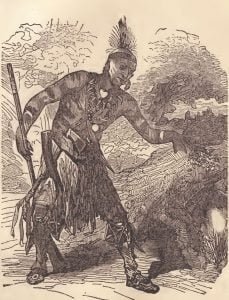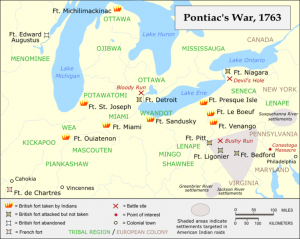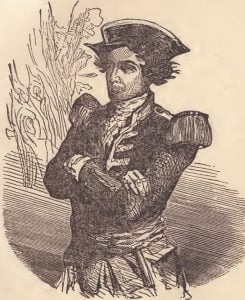A struggle began in 1760, in which the English had to contend with a more powerful Indian enemy than any they had yet encountered. Pontiac, a chief renowned both in America and Europe, as a brave and skillful warrior, and a far-sighted and active ruler, was at the head of all the Indian tribes on the great lakes. Among these were the Ottawas, Miamis, Chippewas, Wyandott, Pottawatomie, Winnebago, Shawanese, Ottagamie, and Mississagas.
After the capture of Quebec, in 1760, Major Rodgers was sent into the country of Pontiac to drive the French from it. Apprised of his approach, Pontiac sent ambassadors to inform him that their chief was not far off, and desired him to halt until he could see him “with his own eyes.”

When Pontiac met the English officer, he demanded to know the business which had brought him into his country, and how he dared to enter it without his permission. The major told him he had no designs against the Indians, but only wished to expel the French; and at the same time, he delivered him several belts of wampum. Pontiac replied, “I stand in the path you travel until tomorrow morning,” and gave the major a belt. This communication was understood to mean, that the intruder was not to march further without his leave. Next day, the English detachment was plentifully supplied with provisions by the Indians, and Pontiac giving the commander the pipe of peace, assured him that he might pass through his country unmolested, and that he would protect him and his party. As an earnest of his friendship, he sent one hundred warriors to aid in driving the cattle belonging to the party, and then accompanied the major as far as Detroit, effectually securing him from the fury of the Indians who had been in the service of the French.
The northwestern tribes retained a hatred of the English after the fall of the French power in America; and Pontiac’s schemes received the ready support of these hardy warriors. Concealing his enmity until he had united these tribes, and arranged his system of warfare, Pontiac completely deceived the English into a feeling of security. In his transactions during the war, he displayed his superiority over all the other Indian chiefs. He appointed a commissary, and issued bills of credit, all of which he carefully redeemed. These bills were made of bark, on which was drawn the article wanted, with the figure of an otter, the insignia of the Ottawas. Pontiac also endeavored to prevent his people from using European commodities and having intercourse with the whites. In 1713, Major Rodgers sent a bottle of brandy to him, which his counselors advised him not to drink. But with true greatness he exclaimed, “It is not in his power to kill him who has so lately saved his life.”
Several traders brought news to the fort at Michilimakinak that the Indians meditated hostilities; but Major Etherington, who was commander of the garrison, would believe nothing of it. Nor were any precautions taken when about four hundred Indians, apparently with friendly intent, assembled in the vicinity. On the 4th of June, the Indians, as if for amusement, began to play a game at ball. Such was the exciting character of the game that a number of the garrison went out to see it. Suddenly, the ball was thrown over the stockade, as if by accident, and the Indians rushing in for it, completely surprised the garrison and took possession of the fort. Seventy of the soldiers were butchered, and the other twenty reserved for slaves. A few days after, a boat from Montreal, with English passengers, came ashore, and all fell into the hands of the wily Indians.
Within fifteen days after taking Michilimakinak, Pontiac was in possession of all the western garrisons except three. This alone is sufficient evidence of the perfection of Pontiac’s plans and the rapidity of their execution. Detroit alone remained in the distant region of the northwest, and this, as will be shown, was brought to the verge of destruction.
Before the news of the massacre of Michilimakinak could reach the garrison at Detroit, that place was closely besieged by the Indians, under the personal direction of their great chief. The garrison consisted of three hundred men, under Major Gladwin. When Pontiac and his warriors came, although in great numbers, they were so intermixed with women and children, and brought so many articles of trade, that suspicion was lulled. Pontiac encamped at some distance from the fort, and sent to Major Gladwin, to inform him that he had come to trade, and wished to hold a talk with him, to “brighten the chain of peace” between the English and the Indians. The major readily consented and. the next morning was fixed for the conference.

The same evening, a circumstance transpired which saved the garrison from a dreadful massacre. When the fort was clear of strangers, an Indian woman was found loitering, and being asked what she wanted, made no reply. The major, informed of her singular demeanor, directed her to be conducted into his presence. When she was brought to him, her answers were so confused and unsatisfactory, that the major suspected she had something to communicate but was restrained by her fears. Being assured of his protection, she told him that the chiefs who were to meet him in council next day, had formed a plan to murder him and the garrison, and take possession of the fort; that each chief would come to the council with his gun under his blanket, and when Pontiac gave the signal, which was the delivery to the major of a belt of wampum, they were to begin their work.
Having thus a full knowledge of the plot, Major Gladwin had every precaution taken to put the garrison in the best possible state for defense. At the appointed hour of ten o’clock, the next morning, Pontiac and his chiefs, and a train of warriors entered the fort. The gates were then closed. The vigilant eye of the Indian chief discovered an unusual degree of activity among the garrison, but his fears were somewhat quieted by being informed that the men were exercising. The council opened, and Pontiac commenced his speech. When he came to the signal of presenting the belt, the peculiar attitudes of the officers and men told the chief that his plot was discovered. The belt was not given, and Pontiac closed his speech with many professions of respect and affection for the English. Major Gladwin then reproached the chief with his treachery, and told him that he knew his whole diabolical plot. Pontiac made an effort to excuse himself and deny that he had intended any injury; but the major stepped to the chief nearest himself, pulled aside his blanket, and exposed the gun, thus completing the confusion of the Indians. They were then ordered to leave the fort.
The next day a furious attack was made. Every stratagem was used by the Indians, but all were defeated by the resolution of the garrison. Finding their efforts vain, they relinquished the attack; but blockaded the fort, cut off its supplies, and reduced the garrison to the greatest distress. Several small vessels, approaching to relieve the besieged, were seized by the Indians and their crews cruelly treated.
In consequence of the great extent of country between Detroit and the other western posts, there was much difficulty encountered in sending relief to the garrison. But Captain Dalyell, with a considerable body of men, succeeded in reaching it on the 29th of July, 1763. Shortly after, Dalyell, with about two hundred and fifty men, went out of the fort with the object of surprising Pontiac in his camp; but the chief had timely notice, and concealing a superior force behind a picket fence, near a bridge, over which the English were to pass, poured upon them a dreadful fire. After a short action, the detachment retreated to the fort, having lost sixty-one men, including Captain Dalyell.
The siege of Detroit was continued twelve months being the longest regular siege the Indians ever maintained. The fame of Pontiac had now reached Europe, and the British government made extensive preparations to crush the power of the Indians. Aware that General Bradstreet was marching to relieve Detroit, with a large force, Pontiac raised the siege and sued for peace, which the English were glad to grant. It may be proper here to state the after career of the greatest of Indian chiefs. He maintained the peace with the English faithfully until his death. When the American Revolution broke out, Pontiac wished to take part with the Americans; but was prevented by Governor Hamilton, of Detroit. During the war, he went into Illinois to an Indian council there, and the English, suspecting his intentions were hostile to them, employed an Indian as a spy upon him. In the council he made a speech unfriendly to the English, and the Indian stabbed him to the heart. Thus fell a man with the true commanding spirit daring, persevering, and sagacious. Among his own race, Pontiac was a warrior whose name was synonymous with success. His fertility of stratagem was only equaled by his firm courage. In short, he possessed most of those qualities which make men great, either among savage or civilized nations.

While Pontiac and his warriors were contending with the English in Michigan, all the tribes in the western part of Pennsylvania and along the Ohio, were active in their operations against the common enemy. The Delawares and the Shawanese were the leading tribes in this quarter. When Detroit was besieged by the Ottawas, Fort Pitt and Niagara, which were furnished with numerous garrisons, well provided, expected the same fate. Niagara was not attacked; and Fort Pitt, commanded by Captain Huger, resisted all the efforts of the Delawares. A body of troops under Colonel Bouquet was sent to the assistance of this place. Proceeding by forced marches, he gained the valley of the Bushy Kun. The defiles appeared to be free. But on the 5th of August, 1763, the English were suddenly surrounded by swarms of Indians, who assailed them on all sides in this narrow passage. The Indian mode of fighting gave them a great ad-vantage in this woody country. In this series of skirmishes, which began about midday, the English succeeded in repulsing every attack of their foes, and drove them from all their positions. But the next morning, they renewed the attack with a much larger force. The English commander then determined to bring the Indians to a decisive battle, if possible.
When the attack commenced, Bouquet ordered the centre line to fall back, in order to draw the Indians into an attack upon this point alone. The right and left wings then retreated into the under wood and formed an ambuscade on each side. The Indians rushed into the passage thus opened for them, full of the belief that their enemies were nearly defeated; but, suddenly, the ambuscade troops appeared on their flanks and rushed upon them with such force that they were almost annihilated. A great number of Indians perished in these two days’ contests, but the number was not accurately known. This was their last attempt to obstruct the progress of Colonel Bouquet’s forces, and after a fatiguing, rapid march, he arrived at Fort Pitt, and compelled the Indians to raise the siege. Not having enough troops to pursue them to the forests of Ohio, Bouquet returned to go into winter quarters in Pennsylvania.
After raising the siege of Fort Pitt, the Indians retreated as far as the Muskingum. There they collected their forces, attached new tribes to their confederacy, and made every preparation for renewing the struggle in the spring. But all their designs were destined to be crushed in the bud. General Gage became commander-in-chief of the British forces in the colonies, and prepared two expeditions against them. One body of troops, under Colonel Bradstreet, proceeded against the Ottawas, the Wyandott, Chippewas, and other tribes near the great lakes. Another under Colonel Bouquet was to attack the tribes between the great lakes and the Ohio.
Bradstreet proceeded by rapid marches to Sandusky, and soon captured all the northwestern forts which the Indians had taken from the English. As before related, Pontiac then sued for peace. The other expedition was delayed until late in August, and Colonel Bouquet did not arrive at Pittsburg until the 17th of September, 1767. Apprehending their danger, the Indians of Ohio were anxious for peace; but their terms were so ambiguous, ‘that Bouquet thought it necessary to penetrate farther into their country, and, accordingly, he proceeded as far as the Muskingum.
The Indians, not being able to check his passage, demanded that a conference should be held on the 18th of October. Bouquet with an efficient force, proceeded to the place appointed, and the chiefs of the Delawares, Shawanese, and Senecas appeared with their principal warriors. The colonel informed them that peace would not be granted unless they would deliver to him all prisoners whom they held in possession. This was to be done within twelve days. On the first day, the Delawares delivered eighteen whites, and collected a bundle of sticks to signify that they had eighty-three more, who were then absent. The Shawanese refused to make such an engagement, until Colonel Bouquet advanced into their country as far as the Sciota; they then agreed to the demand.
On the 9th of November, two hundred and six English prisoners were brought into camp; and on the same day, another conference was held, to conclude a treaty of peace. Even in defeat, the Shawanese retained all their pride and spirit, declaring that they only gave up the war in commiseration of their wives and children. The arrival of the prisoners in camp afforded a very affecting scene. There was the meeting of father and child, husband and wife, brothers and sisters. Some looked for those they had lost, but they were not there, and the full heart prevented them from asking for them. The Indians delivered their captives with great regret, having become attached to them, and looking upon them as their own people. Many of the captives had adopted the Indian mode of life, and did not seem anxious to give it up. A few afterwards escaped from the settlements and returned to the Indians.
Having accomplished its design, the army proceeded homeward, and reached Pittsburg on the 28th of November. Colonel Bouquet returned to Philadelphia in January, 1765, where the representatives of Pennsylvania tendered him and his soldier’s thanks for their services. The same was done by the representatives of Virginia; and George III., of England, appointed the colonel a brigadier-general, and gave him the command of his armies in the southern provinces.
